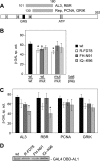Functional analysis of a novel motif conserved across geminivirus Rep proteins
- PMID: 21084480
- PMCID: PMC3020519
- DOI: 10.1128/JVI.02143-10
Functional analysis of a novel motif conserved across geminivirus Rep proteins
Abstract
Members of the Geminiviridae have single-stranded DNA genomes that replicate in nuclei of infected plant cells. All geminiviruses encode a conserved protein (Rep) that catalyzes initiation of rolling-circle replication. Earlier studies showed that three conserved motifs-motifs I, II, and III-in the N termini of geminivirus Rep proteins are essential for function. In this study, we identified a fourth sequence, designated GRS (geminivirus Rep sequence), in the Rep N terminus that displays high amino acid sequence conservation across all geminivirus genera. Using the Rep protein of Tomato golden mosaic virus (TGMV AL1), we show that GRS mutants are not infectious in plants and do not support viral genome replication in tobacco protoplasts. GRS mutants are competent for protein-protein interactions and for both double- and single-stranded DNA binding, indicating that the mutations did not impair its global conformation. In contrast, GRS mutants are unable to specifically cleave single-stranded DNA, which is required to initiate rolling-circle replication. Interestingly, the Rep proteins of phytoplasmal and algal plasmids also contain GRS-related sequences. Modeling of the TGMV AL1 N terminus suggested that GRS mutations alter the relative positioning of motif II, which coordinates metal ions, and motif III, which contains the tyrosine involved in DNA cleavage. Together, these results established that the GRS is a conserved, essential motif characteristic of an ancient lineage of rolling-circle initiators and support the idea that geminiviruses may have evolved from plasmids associated with phytoplasma or algae.
Figures





Similar articles
-
Conserved sequence and structural motifs contribute to the DNA binding and cleavage activities of a geminivirus replication protein.J Biol Chem. 1998 Sep 18;273(38):24448-56. doi: 10.1074/jbc.273.38.24448. J Biol Chem. 1998. PMID: 9733736
-
Geminivirus replication: genetic and biochemical characterization of Rep protein function, a review.Biochimie. 1995;77(10):765-73. doi: 10.1016/0300-9084(96)88194-6. Biochimie. 1995. PMID: 8824773 Review.
-
Mutational analysis of the helicase domain of a replication initiator protein reveals critical roles of Lys 272 of the B' motif and Lys 289 of the β-hairpin loop in geminivirus replication.J Gen Virol. 2014 Jul;95(Pt 7):1591-1602. doi: 10.1099/vir.0.064923-0. Epub 2014 Apr 11. J Gen Virol. 2014. PMID: 24728710
-
A DNA structure is required for geminivirus replication origin function.J Virol. 1996 Jan;70(1):148-58. doi: 10.1128/JVI.70.1.148-158.1996. J Virol. 1996. PMID: 8523519 Free PMC article.
-
Geminiviruses and the plant cell cycle.Plant Mol Biol. 2000 Aug;43(5-6):763-72. doi: 10.1023/a:1006462028363. Plant Mol Biol. 2000. PMID: 11089875 Review.
Cited by
-
A tripartite ssDNA mycovirus from a plant pathogenic fungus is infectious as cloned DNA and purified virions.Sci Adv. 2020 Apr 3;6(14):eaay9634. doi: 10.1126/sciadv.aay9634. eCollection 2020 Apr. Sci Adv. 2020. PMID: 32284975 Free PMC article.
-
Genomoviruses in Liver Samples of Molossus molossus Bats.Microorganisms. 2024 Mar 29;12(4):688. doi: 10.3390/microorganisms12040688. Microorganisms. 2024. PMID: 38674632 Free PMC article.
-
A Novel DNA Motif Contributes to Selective Replication of a Geminivirus-Associated Betasatellite by a Helper Virus-Encoded Replication-Related Protein.J Virol. 2015 Dec 9;90(4):2077-89. doi: 10.1128/JVI.02290-15. Print 2016 Feb 15. J Virol. 2015. PMID: 26656709 Free PMC article.
-
High molecular diversity and divergent subpopulations of the begomovirus cnidoscolus mosaic leaf deformation virus associated with Cnidoscolus urens.Arch Virol. 2021 Dec;166(12):3289-3299. doi: 10.1007/s00705-021-05245-1. Epub 2021 Sep 23. Arch Virol. 2021. PMID: 34554304
-
The replication initiator protein of a geminivirus interacts with host monoubiquitination machinery and stimulates transcription of the viral genome.PLoS Pathog. 2017 Aug 31;13(8):e1006587. doi: 10.1371/journal.ppat.1006587. eCollection 2017 Aug. PLoS Pathog. 2017. PMID: 28859169 Free PMC article.
References
-
- Arguello-Astorga, G. R., and R. Ruiz-Medrano. 2001. An iteron-related domain is associated to motif 1 in the replication proteins of geminiviruses: identification of potential interacting amino acid base pairs by a comparative approach. Arch. Virol. 146:1465-1485. - PubMed
-
- Arnold, K., L. Bordoli, J. Kopp, and T. Schwede. 2006. The SWISS-MODEL workspace: a web-based environment for protein structure homology modeling. Bioinformatics 22:195-201. - PubMed
Publication types
MeSH terms
Substances
LinkOut - more resources
Full Text Sources

